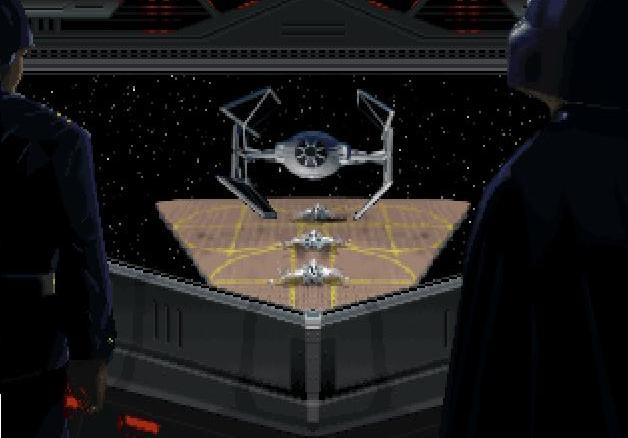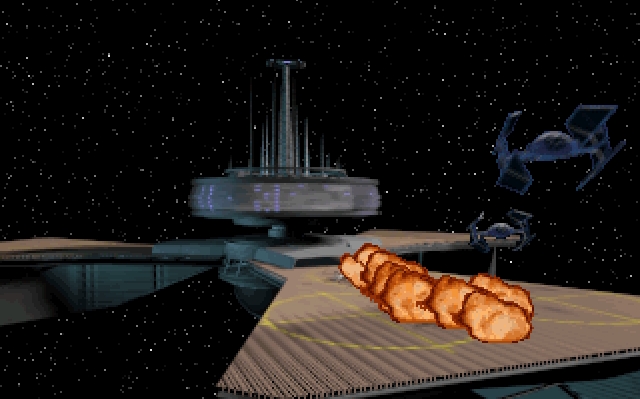The XQ Platform series were a group of quick construction space installations produced by multiple companies including Bengel Shipbuilders, Telgorn Corporation, and Xizor Transport Systems.

From the bridge of an XQ2 Platform, Admiral Zaarin and Darth Vader watch a demonstration of the new TIE Avenger.
The XQ series was armed with six laser cannons, two at the corners of each docking platform. There were also three twin turbolaser turrets, either mounted on the top of each of the hangars, or on the central hub of the space station if that happened to overshadow the hangars. Newer platforms (XQ3 to XQ6) often mounted an additional three turrets, for a total of six, on the underside of the hub as this is a common blind spot in older designs.
The central hub of the Platform contained communication antennae and the conning tower or bridge.
Occasionally, high-priority platforms, such as the TIE Defender research facility in the Parmel system, had a concussion missile launcher positioned at the tip of its underside. While it was often used to discourage starfighter attacks, its most important role was to intercept incoming warheads before they could harm the station. Attacking fighters often had to use several concussion missiles of their own to overwhelm this anti-warhead defense.
The XQ series hangars could accommodate up to three squadrons of starfighters, plus transports, shuttles, and other auxiliary craft.
Most XQ series platforms served as outposts and supply depots for both sides in the Galactic Civil War, such as DS 5 where defecting Imperial Admiral Harkov took refuge. Outpost D-34 and NL-1 served as Imperial customs stations, tasked with guarding major hyperspace lanes and bringing order to the sector.
Others were research installations, like Admiral Zaarin's TIE Defender facility in the Parmel system, and Pondut and RS-32 which housed magnetic pulse warhead technology used by the Rebellion.
The XQ Platforms were first introduced in Star Wars: TIE Fighter, replacing the combinations of freighters and cargo containers used to represent space stations in the preceding Star Wars: X-Wing.
The naming nomenclature has changed through the X-wing series; for instance in Star Wars: TIE Fighter, the station were referred to as "Platform Class 1 (PLT/1)", while the following Star Wars: X-Wing vs. TIE Fighter it was called "XQ1 Platform". Star Wars: X-Wing Alliance added further information on the manufacturers of the Platforms.
In Star Wars: TIE Fighter, the concourse is a large circular atrium with a central column (perhaps containing the turbolifts), which could imply that it is an XQ series platform rather than a Star Destroyer. If so, this is the only depicted interior of an XQ platform.
The XQ2 appears to be most popular platform. In Star Wars: TIE Fighter, platforms very similar to the XQ2 (and to a lesser extent, the XQ5) are seen in several cutscenes, such as the introduction (representing a Rebel outpost), Tour of Duty 3 (the new NL-1 in the Pakuuni system) and Tour of Duty 4 (the test facility for TIE Avengers). The cover art of X-Wing: The Krytos Trap likely depicts an XQ2 as well. There are several differences between the XQ2 and the platforms depicted in cutscenes/artwork, however, most notable is their undersides where the XQ2's is flat while the latter is semi-spherical.

Zaarin's TIE Avenger demonstration for Lord Vader at a Platform, likely an XQ2.
In Star Wars: TIE Fighter Tour of Duty 3, there is an inconsistency between Missions 5 and 6, the NL-1 platform changes from a XQ3 to an XQ1. (Similarly in Tour of Duty 1, there is a blooper as Fogger is first represented by a Nebulon-B escort frigate and then a Nebulon-B2 frigate, in missions 3 and 4, respectively.)
There is some discrepancy in the size of the XQ Platform series. In TIE Fighter, an XQ station had a diameter of around one third of a kilometer, with each docking arm being appropriate in size for a YT-1300 light freighter or several X-wings/Z-95 Headhunters. At the end of Tour of Duty 3, an XQ2 platform is shown as much smaller than an Imperial Star Destroyer standing guard alongside. Graphically updated with textures for Star Wars: X-Wing vs. TIE Fighter, the XQ models remained the same size.
However, with the release of Star Wars: X-Wing Alliance, the XQ stations had been rescaled to three times the size, now having a diameter of around a kilometer. Each docking arm was now able to comfortably accommodate several spacecraft as large as a CR90 corvette. The cover art for X-Wing: The Krytos Trap also gives a similar comparison of the XQ Platform (perhaps an XQ2) to X-wings, TIEs, and a CR90 corvette.